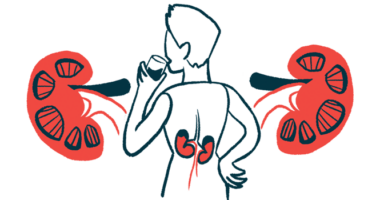New DGKE mutation leads to early aHUS onset, poor prognosis in boy
Exon 4-6 deletion is novel DGKE variant that may have caused boy's disease

A case study of atypical hemolytic uremic syndrome (aHUS) caused by a new mutation in the DGKE gene highlights the disease’s early onset and severe difficult-to-treat course.
The report, “Clinical features and management of atypical hemolytic uremic syndrome patient with DGKE gene variants: a case report,” was published in the journal Frontiers in Pediatrics.
Mutations in many genes have been linked to aHUS
In aHUS, abnormal activation of a part of the immune system, called the complement system, leads to blood clotting and inflammation in the body’s small blood vessels. Most people with aHUS have mutations that disrupt complement activity, setting the stage for the disorder to develop.
Mutations in many different genes have been reported to be associated with aHUS. The first report of aHUS caused by mutations in the DGKE gene was published about a decade ago. Since then, there have been several other reports of mutations in this gene causing aHUS, usually resulting in severe disease that develops in early childhood.
Here, researchers in China reported the case of a seven-month-old boy who was referred to their clinic due to presumed kidney problems, with symptoms that included swelling in the eyelid and limbs. A few days into his hospital stay, the boy developed fever, vomiting, and diarrhea, accompanied by further swelling and unusually dark urine.
These symptoms, along with laboratory test results, were generally indicative of hemolytic uremic syndrome (HUS). Further tests showed that the boy did not have an infection caused by bacteria producing Shiga toxin, the cause of the so-called typical HUS. However, some bacteria that can be disease-causing, including Escherichia coli and Streptococcus, were found in his stool.
Given the concern for HUS and infection, the boy was started on broad-spectrum antibiotics and anti-inflammatory therapies, including intravenous immunoglobulin and low-dose corticosteroids. He also received blood cell infusions and other medications in an attempt to control his various symptoms.
aHUS with DGKE variants can occur at any age but typically manifests in the first year of life and has a poor prognosis with a higher rate of mortality.
Boy’s condition continued to worsen
Over the course of the boy’s hospital stay, his condition continued to worsen. He experienced problems breathing and his kidney function continued to decline. He then had a bleed in the brain. These problems continued to worsen despite intensive treatments, and eventually the boy’s parents decided to stop further attempts at treatment. The child died about eight weeks after being admitted to the hospital.
Subsequently, genetic sequencing was performed on blood samples from the boy, his parents, and an older sibling.
Results showed the baby had two different mutations in the DGKE gene. When associated with DGKE mutations, aHUS is typically inherited in an autosomal recessive manner, meaning that the disease will only develop if both gene copies are mutated.
One of the mutations, referred to as p.Thr204Asnfs*4, was not found in either of the boy’s parents, suggesting it developed de novo — meaning the mutation occurred by chance early on in the boy’s development, and was not inherited from a parent. This specific mutation in DGKE had been previously associated with aHUS in other cases.
Boy had novel DGKE variant that ‘may be disease-causing’
The other mutation, referred to as exon 4-6 deletion, was found in the boy and also his father, who did not have any symptoms of aHUS. This mutation had not been previously reported, according to the researchers.
“To the best of our knowledge, the exon 4-6 deletion is a novel DGKE variant, and may be disease-causing,” they wrote.
The researchers noted that many of the features seen in this case, including the early age at disease onset and difficulty treating the disorder, have also been reported in other cases of aHUS caused by DGKE mutations.
“The present literature suggests that aHUS with DGKE variants can occur at any age but typically manifests in the first year of life and has a poor prognosis with a higher rate of mortality,” they wrote, adding that “the relatively early disease onset and the heartbreaking outcomes reflects the complexity of DGKE-aHUS as well as the intractability of treatment.”








